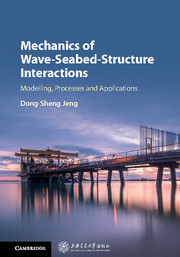Book contents
- Frontmatter
- Contents
- Preface
- 1 Overview
- 2 Basic Seabed Mechanisms
- 3 Soil Response in Marine Sediments under Combined Loading of Waves and Currents
- 4 Integrated Model of Wave-Seabed Interactions around Caisson-Type Breakwaters
- 5 Mechanics of Wave-Seabed-Pipeline Interactions
- 6 Three-Dimensional Model of Wave-Seabed Interactions around Breakwater Heads
- 7 Seabed Instability around Offshore Wind Turbine Foundations
- 8 Physical Modelling: One-Dimensional Compressive Tests
- Appendix A Analytical Solution for a Seabed of Finite Thickness (Hsu & Jeng 994)
- Appendix B Derivation of u–p Approximation (Jeng et al. 1999)
- Appendix C Derivation of u–U Approximation (Cha et al. 2002)
- Appendix D Mathematical Derivations of Analytical Solutions for Residual Soil Response (Jeng et al. 2007)
- Appendix E Mathematical Model of the Two-Layered Viscous Fluid System (Liu et al. 2009)
- References
- Author Index
- Subject Index
7 - Seabed Instability around Offshore Wind Turbine Foundations
Published online by Cambridge University Press: 28 April 2018
- Frontmatter
- Contents
- Preface
- 1 Overview
- 2 Basic Seabed Mechanisms
- 3 Soil Response in Marine Sediments under Combined Loading of Waves and Currents
- 4 Integrated Model of Wave-Seabed Interactions around Caisson-Type Breakwaters
- 5 Mechanics of Wave-Seabed-Pipeline Interactions
- 6 Three-Dimensional Model of Wave-Seabed Interactions around Breakwater Heads
- 7 Seabed Instability around Offshore Wind Turbine Foundations
- 8 Physical Modelling: One-Dimensional Compressive Tests
- Appendix A Analytical Solution for a Seabed of Finite Thickness (Hsu & Jeng 994)
- Appendix B Derivation of u–p Approximation (Jeng et al. 1999)
- Appendix C Derivation of u–U Approximation (Cha et al. 2002)
- Appendix D Mathematical Derivations of Analytical Solutions for Residual Soil Response (Jeng et al. 2007)
- Appendix E Mathematical Model of the Two-Layered Viscous Fluid System (Liu et al. 2009)
- References
- Author Index
- Subject Index
Summary
Introduction
Ambitious wind power development programs were launched by many countries to promote the exploitation of renewable energy and a significant part of the expansion will occur in the form of offshore wind farms (Danish Energy Authority 2005). In Denmark, for example, 28 per cent of the electricity is now produced from wind, and the figure is predicted to reach 50 per cent by 2020 which means the current capacity will be extended by 2000 MW wind power before 2020, and 1500 MW will come from offshore wind farms.
The foundation of an offshore wind turbine, which transfers the forces from the structure to the surrounding soil, is a critical part in the design of a wind turbine structure and it may account for up to 35 per cent of the total installed cost (Byrne & Houlsby 2013). The foundation options usually are gravity-based foundations and monopiles for shallow water, suction caissons and multiple-footing foundations for relatively deep water, and floating options for much deeper water (Breton & Moe 2009).
Linton & Evans (1990) made major simplifications to the calculation of forces and free-surface amplitudes and exploited the exact theory for the scattering of waves by N vertical circular cylinders developed by Spring & Monkmeyer (1974). Subsequently, many theoretical studies in terms of wave–vertical pile interactions were carried out (Evans & Porter 1997; Malenica, Taylor & Huang 1999; Li, Zhang, Guan & Lin 2013). Recently, Liu, Li & Li (2007) experimentally investigated the group effectiveness and the effect of superstructures on wave current forces. Research on the response of offshore foundations to cyclic loads such as wave loadings has been conducted over the past few decades, and a series of two-dimensional (2D) and three-dimensional (3D) models have been developed to obtain a better understanding of the interactions between soil and pile foundations (Randolph 1981; Yang & Jeremic 2002). However, pore-water pressures have been left out of the preceding works and the soil was considered a material without voids. In addition, engineers tend to increase pile stiffness or soil ultimate bearing capacity to avoid foundation failure. As a matter of fact, pore-water pressure that accumulates in the wave-action process may lead to a decrease of effective stress and eventual collapse of the upper structure.
- Type
- Chapter
- Information
- Mechanics of Wave-Seabed-Structure InteractionsModelling, Processes and Applications, pp. 253 - 284Publisher: Cambridge University PressPrint publication year: 2018



